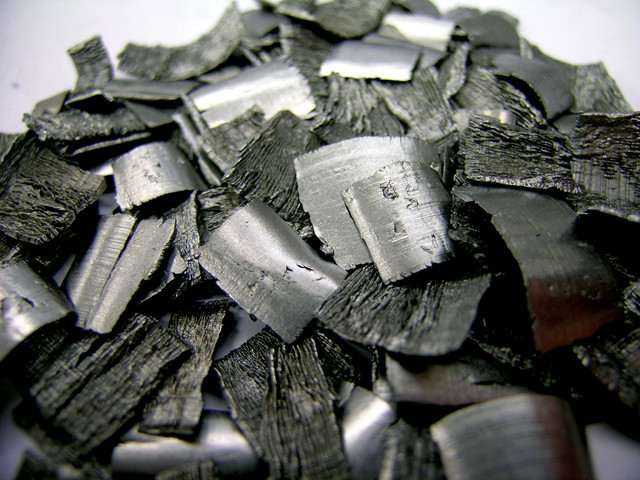Mineral Resource of the Month: Hafnium
by U.S. Geological Survey
Wednesday, June 13, 2018
George Bedinger, a mineral commodity specialist for the U.S. Geological Survey, compiled this information on hafnium, a metal used in superalloys and the nuclear industry.
Hafnium is a ductile metal with a brilliant silver luster. It does not exist as a free element in nature; it is always associated with zirconium. Its existence was predicted as early as 1869 by Dmitri Mendeleev, but it wasn’t discovered until 1923 when it was found in the mineral zircon by X-ray spectroscopic analysis. Hafnia is the Latin name for Copenhagen, the city where hafnium was discovered.

Hafnium is pyrophoric — it can easily ignite and burn at high temperatures. Credit: ©Deglr6328, Creative Commons Attribution-ShareAlike 3.0 Unported
The chemical properties of hafnium and zirconium are almost identical, which make them two of the most difficult elements to separate. It can be done, however, using a solvent extraction process. Commercial production of hafnium metal is based on the reduction of hafnium tetrachloride to hafnium metal. Hafnium is further refined using the crystal bar process, in which hafnium tetraiodide is passed over a tungsten filament creating a crystal bar of pure metal.
The primary source of hafnium is heavy mineral sands that contain zircon, typically with a hafnium to zirconium ratio of approximately 1 to 50. Australia and South Africa are the world’s leading producers of these heavy mineral sands. Although estimates of hafnium resources are not available, global zirconium reserves are estimated to be 48 million metric tons.
While hafnium and zirconium have almost identical chemical properties, they have nearly opposite nuclear absorption properties. Hafnium readily absorbs neutrons, while zirconium does not. This difference is exploited in the production of nuclear reactor fuel rods, in which zirconium is used as a cladding material, and in hafnium control rods to take advantage of its high neutron absorption.
In addition to its use in nuclear applications, hafnium is used in superalloys. Owing to its high melting point of 2,233 degrees Celsius, hafnium improves tensile strength and is commonly added to nickel-base alloys used in jet engines and to niobium-based alloys used for rocket engine thruster nozzles. Hafnium is also used as an insert for plasma welding tips, where its high melting point extends the life of the tips and enhances performance, and in niobium-base alloy coatings used in cutting tools.
In electronic applications, hafnium tetrachloride and hafnium oxide are used in microprocessors because the temperature resistance of these compounds make them good substitutes for silicon. Hafnium oxide is used in blue lasers in DVD readers, and hafnium is used in thin film coatings to provide hardness and protection for optical systems.
Production and demand data for hafnium are difficult to assess, owing to a small customer base and the close association with the nuclear industry. Demand for hafnium is strong in the plasma and superalloy industries, as well as in the growing nuclear industry, particularly in China, which produced its first batch of nuclear-grade zirconium sponge metal in September 2012.
For more information on hafnium and other mineral resources, visit:
minerals.usgs.gov/minerals.
__Hafnium production and consumption__
The recovery of hafnium takes place during the refinement of zirconium where nuclear-grade pure zirconium is required. Without a nuclear industry, it is likely that no hafnium would be recovered because its low concentration in zirconium metal would otherwise make its recovery too costly.
Because there are few producers of hafnium, published prices are not available. At the end of 2012, the import value of unwrought hafnium from France, the only other major producer of nuclear-grade hafnium metal outside the U.S., was $542 per kilogram.
__Fun facts__
An alloy consisting of 89 percent niobium, 10 percent hafnium and 1 percent titanium is used for liquid rocket thruster nozzles and was used in the engines of the Apollo Lunar Landing Modules.
Tantalum hafnium carbide has the highest melting point of any known compound (4,215 degrees Celsius).
Hafnium is used in nuclear control rods, especially on nuclear submarines.

